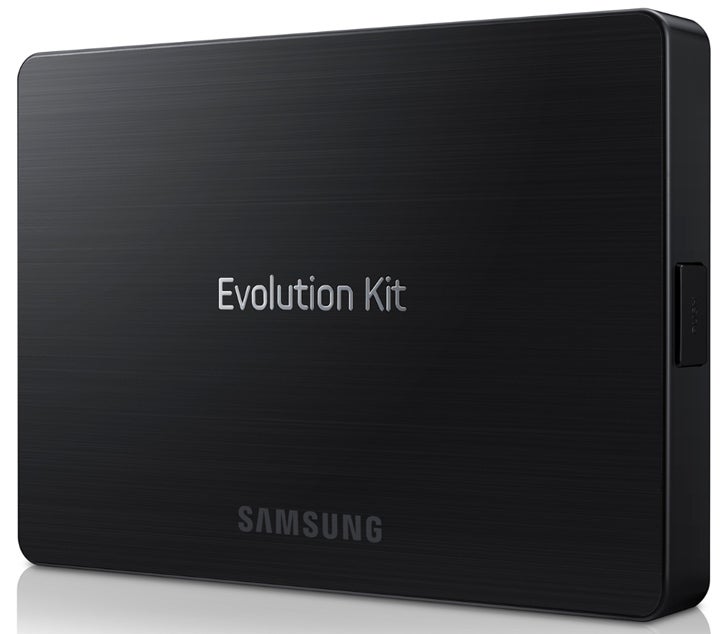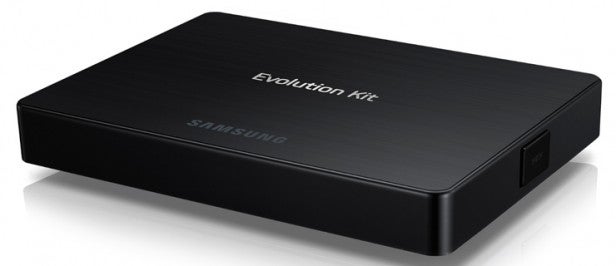Samsung SEK-1000 TV Evolution Kit Review - Limitations and Conclusions Review
Limitations and Conclusions
Make your old Samsung TV new again with this unique upgrade system

Sections
- Page 1 Samsung SEK-1000 TV Evolution Kit Review
- Page 2 Installation and Performance Review
- Page 3 Limitations and Conclusions Review
Despite going way further with the extent of its upgrades than any simple firmware update could ever accomplish, though, the Evolution Kit doesn’t completely convert your 2012 TV into a 2013 one. There are hardware issues that even replacing chipsets can’t sort out.
For instance, the physical camera built ES7000/ES8000 models can’t magically be made as good as the one in the F7000/F8000 series. Also, the upgrade doesn’t enable your 2012 TV to support screen mirroring with external smart devices, and if you’re fond of printing directly from your ES7000/ES8000 you should note that this 2012 TV feature is removed by the Evolution Kit upgrade.
Next, while it can deliver some picture improvements, the upgrade can’t do much about the slight backlight clouding flaws on the ES7000 and ES8000 models – not least because its backlight system can’t deliver the F7000/F8000 Cinema Black feature, which is based on a limited form of local dimming.
For the sake of completeness we think it would be nice if Samsung posted on its website a full list of all the 2013 TV features you don’t get with the Evolution Kit.
There’s also a bit of a grey area about how many generations of Evolution Kit you might reasonably expect to be able to add to your 2012 TV. Will it only work with this year’s kit? Could you get another upgrade when the second generation of Evolution Kits launches (Samsung is not committing to doing these annually)? Or even the generation after that as well? At the moment Samsung refuses to be drawn on these questions.
A key innovation for the future?
Returning to stuff we can talk definitively about, though, from spending
many hours using both Samsung’s new TVs and now the Evolution Kit
applied to one of 2012’s TVs, we’d say that the screen mirroring and
Cinema Black features were the only ones we missed even a little on our
upgraded 2012 TV versus an actual 2013 TV.
In fact, now that we’ve actually had chance to experience an Evolution Kit, we really can see them being a serious element in some consumers’ current TV buying decisions. After all, in this fast-changing technological world, having the peace of mind that buying a Samsung F7000 or F8000 as your next TV means it will be largely futureproof for at least one year down the line seems very appealing.
This is especially true where Samsung’s new Ultra HD (4K) TVs are concerned. For rather brilliantly Samsung maintains that next year’s Evolution Kits could carry new HDMI ports able to support whatever HDMI specification gets ratified for the 4K world in the coming months.
No other TV brand right now can claim this sort of Ultra HD futureproofing, and it could be a hugely persuasive point for many early adopters feeling scared off buying other Ultra HD TVs this year by worries about whether they’ll be able to handle as yet undefined Ultra HD standards.
Should I buy the Samsung SEK-1000 Evolution Kit?
Obviously if you don’t have one of 2012’s Samsung ES7000 or ES8000 TVs, then the immediate answer to the above question is a resounding no. Unless you want a £250 beer coaster.
If you do have one of those TVs, however, we’d answer the same question with an equally resounding yes. For tucked away inside that unassuming little metal box is enough horsepower to pretty much give you a whole new TV – a fact that makes its £250 price tag much easier to swallow than we’d frankly expected it to be.
Verdict
From being something we felt rather suspicious about when we first heard of them last year, we now consider Samsung’s Evolution Kits to be one of the most significant AV innovations of not only this year but potentially a good few more years to come. We hope Samsung continues the idea and improves upon it future.
How we test televisions
We test every TV we review thoroughly over an extended period of time. We use industry standard tests to compare features properly. We’ll always tell you what we find. We never, ever, accept money to review a product.


